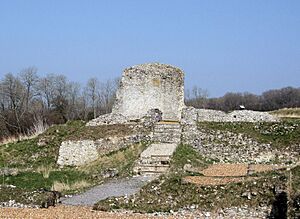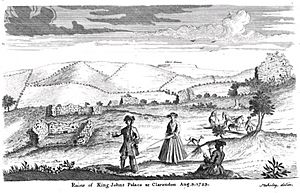Clarendon Palace facts for kids
Clarendon Palace is the ruin of a very old palace from the Middle Ages. It's about 2.25 miles (3.6 km) east of Salisbury in Wiltshire, England. This palace was a special home for kings and queens during the Middle Ages. It was also where important rules called the Constitutions of Clarendon were created. Today, the ruins are inside the beautiful grounds of Clarendon Park.
A Roman Past
People have found clues that the Romans often used the area around Clarendon Forest. A Roman road that connected to Old Sarum, an old Iron Age hillfort, runs about 2 miles (3.2 km) north of the forest. These discoveries suggest that many people lived in this area during Roman times.
A Royal Hunting Spot
Clarendon Forest was probably a royal hunting ground even before the Normans arrived. Records show that from 1070 onwards, it was sometimes used as a place for armies to gather. The name Clarendon was first written down in 1164. It might come from an old English name meaning "hill connected to Clare."
The Norman kings also enjoyed visiting this area. King Henry I likely made it a proper hunting park in the early 1100s. Inside the park, there were open grassy areas, small woods, meadows, and places where animals could graze. By 1130, a special hunting lodge (a small house for hunters) was built in the park.
From Lodge to Palace
Both King Henry II and King Henry III spent a lot of money and effort to turn the hunting lodge into a grand royal home and palace. A lot of building work happened in the early to mid-1200s. This included building the King's Chapel and the Antioch chamber. A person named Elias of Dereham, who also helped build Salisbury Cathedral, was in charge of this work.
In 1164, King Henry II created the Constitutions of Clarendon here. These were a set of rules that tried to limit the special powers of the Church and reduce the Pope's authority in England. A monument put up in 1844 at the site says that the ideas started here helped to change the Church of England later on.
At its biggest, the palace had several buildings around a main courtyard, all inside a small wall. The palace was shaped like a rectangle, about 240 meters (787 feet) long and 80 meters (262 feet) wide, covering more than 5 acres (20,000 m²). It even had terraced gardens.
Queen Eleanor of Provence, King Henry III's wife, had very nice rooms at Clarendon in the 1250s. Her apartments had a hall, a chapel, and several chambers, some of them very large. Her rooms had fancy fireplaces with marble columns and windows that looked out onto a garden. The chapel had a marble altar and religious pictures. The floors in some rooms were made of beautiful patterned tiles. A piece of one of these old tiled floors from 1250–52 can still be seen at the British Museum today!
In 1453, King Henry VI first showed signs of illness at Clarendon Palace. After this, the palace was used less and less. By 1500, it was no longer being looked after. In 1574, it was described as just a simple hunting lodge again. Even when Queen Elizabeth I visited that year, the buildings were in such bad shape that she had to eat in a temporary "banquett house."
Falling Apart
In 1649, after King Charles I was executed, the Parliament took control of Clarendon Palace. When King Charles II returned to the throne in 1660, the park briefly went to George Monck. Then, in 1664, it was given to Edward Hyde. He had already taken the title Earl of Clarendon in 1661, expecting to get the estate.
A new, grand house called Clarendon Park was built in a different part of the park in the early 1700s. Clarendon Palace was left alone and slowly fell apart. By the 1700s, the ruins were just a romantic sight in the landscape or used as simple farm buildings.
Archaeologists have dug at the site many times, between 1933 and 1939, and again in the 1950s, 60s, 70s, and 80s. They found a tile-kiln (a special oven for making tiles) on the site. This kiln has been rebuilt and is now at the British Museum.
Today, the only part of the palace still standing above ground is one end wall of the Great Hall. The site is a protected historical monument.
Images for kids
-
Ruins of King Johns Palace at Clarendon, engraving after William Stukeley, 1723





